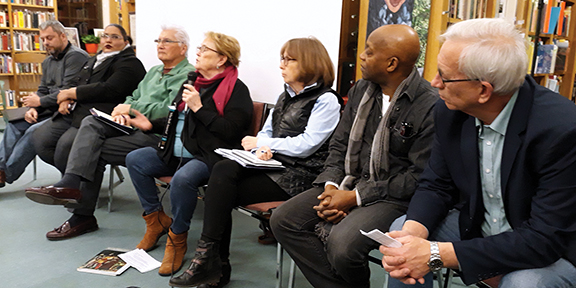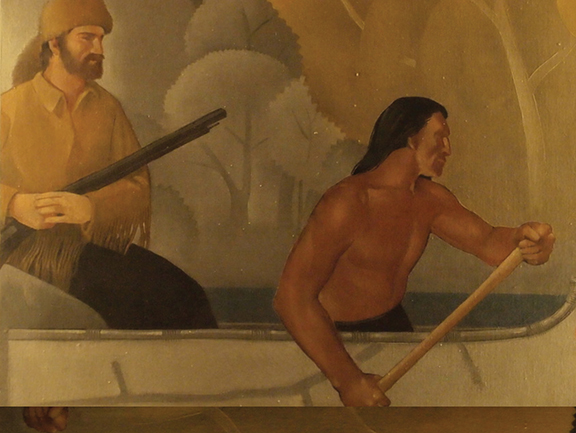
By scott russell
Four large murals in St. Paul City Hall depict white supremacy and Manifest Destiny, creating an unwelcoming space for many citizens who come there to speak to their elected council members and county commissioners. The Ramsey County Historical Society is creating a task force of community members to select and guide local artists in creating new art that will cover two of the four murals at any one time.
Advocacy still is needed to convince local leaders that all four murals should be moved to a different location, such as a museum. Still, there is a great opportunity for people to help select the new art. The Historical Society is seeking task force applicants, according to a recent posting on the Historical Society website. Chad Roberts, President of the Ramsey County Historical Society, will chair the 11-member group.
What is emerging in Ramsey County is part of an ongoing national debate around public art, whether it’s Confederate statues in the south or art in the Minnesota State Capitol.
The four large vertical murals in chambers shared by the Ramsey County Commission and the St. Paul City Council were installed in 1931. Each mural depicts a scene from St. Paul’s development, from early explorers to an industrialized city.
Dominating the top half of each mural is a white man: A voyageur, a surveyor, a river boat captain and an industrial worker. The bottom of each mural has a series of smaller scenes.
Women are almost absent from the art. When a scene shows a white man with a person of color, almost without exception the white man is positioned above them in the place of power. For instance, there is a small image of an explorer and a Native man in a canoe; the Indian paddles while the white explorer coasts while cradling a gun. In another image, a priest extends a cross of conversion to two Native men positioned below him. In yet another, a businessman and his wife disembark a train while the African American porter carries their bags.
These aren’t welcoming images. Crystal Norcross, a Dakota woman, said she has a hard time making her points in St. Paul City Council meetings because of the murals, and she refuses to take her children into the room.
Norcross made her comments at a Jan. 10 community discussion on the murals at the East Side Freedom Library. “These murals got to go …” Norcross said “If you truly respect Dakota people, this is not a hard ask.”
Norcross was one of several panelists, which included: Roberts, Ramsey County Historical Society; John Poupart, founder of the American Indian Policy Center; historian Mary Wingert; St. Paul City Council member Jane Prince; Seitu Jones, a St. Paul visual artist; and Jim McDonough, Ramsey County Board Chair.
Wingert drew a distinction of the murals as “history” vs. “heritage.” The goals are different, she said. History is truth telling, while heritage “confirms for us all the good things we think about ourselves.”

Wingert argued the murals were intended to be heritage, and said they were “highly regarded art.”
Later in the discussion, an audience member who identified himself as a Dakota elder said, “To me, we are talking about the perpetuation of racism. We don’t need to distinguish between history and heritage. We are talking about changing the narrative.”
While Wingert began the evening arguing that the murals should be left in place, she ended the evening saying she was convinced they should be moved.
Roberts opened his statement by acknowledging the meeting was taking place on Dakota land. “Respect for that is important.” He said,“Changing these murals won’t end racism or inequity. These conversations will.”
Jones said one of his forebearers was born into slavery in the 1840s and later came up river and got a job as a porter at the St. James Hotel. He put himself on the side of the people who believe all the murals should be removed.
Jones recalled a recurring conversation from his youth, when an African American man he knew was asked him, “What’s going on?” His response was always the same, “White man’s still on top.”
“The murals help reinforce that attitude,” Jones said.
The two elected officials attending the meeting had differing views. County Board Chair McDonough favored the current plan of keeping the historic murals in place and covering two of them at any one time (on a rotating basis). “We can’t hide our history,” he said.
City Council member Prince said the mural debate went back at least to the 1970s when Ruby Hunt was on the Council.
“I truly find [the artwork] disgraceful,” she said. “Are we still viewing our constituents of color the same way we did in 1932?”
“These murals have to come down,” Prince said.
Approximately 30 people attended the talk. During the audience Q&A one member suggested creating artwork that looked more to the future. Another commented that the artwork made them cringe. A young Dakota woman said when she saw the art she cried.
“I still question and wonder why we are so concerned about having one white man’s depiction of history rather than the people in our own community?” she said.
The first task force meeting will be February 28th at 3pm and will take place in the Courthouse.
Those interested in being on the task force can find info and apply online at: https://rchs.z2systems.com/np/clients/
rchs/survey.jsp?surveyId=10&
Reprinted with permission from
https://healingmnstories.wordpress.com.






